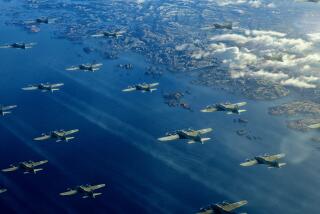Air Base Honors 50 Years of Moxie
- Share via
Ever since the first biplane sputtered across the Mojave Desert, pilots have scanned the terrain below in search of a safe place to land. None could be more hospitable than the vast dry lakes that span the horizon at the northern edge of Los Angeles County.
With 44 square miles of concrete-solid clay and sand, Rogers Dry Lake and its smaller twin, Rosamond Dry Lake, have stood ready as nature’s longest runway.
Smooth as porcelain and nearly impermeable, they have welcomed back men and women from more than 100 record-setting flights, including supersonic aircraft and the space shuttle. And countless more times, the vast, forgiving beds have served as safety nets for pilots and crews aboard planes in trouble, and are credited with sparing more than $1 billion worth of malfunctioning machinery.
On Friday, the most famous pilots in the world paid homage to their special landing place, marking the 50th anniversary of the Air Force Flight Test Center at Edwards Air Force Base.
As two F-117 Nighthawks streaked wingtip to wingtip through the azure sky, dedication ceremonies opened precisely at 9 a.m., as the center was designated as a historic site by the American Institute of Aeronautics and Astronautics.
A daylong celebration followed, as 200 dignitaries and guests toured portions of the complex, whose restricted airspace is the size of Connecticut, Rhode Island and Massachusetts combined. The base itself occupies 470 square miles, an area three times larger than the San Fernando Valley, said Ranney Adams, spokesman for the Air Force Research Laboratory at the base.
Friday’s program ended in a two-hour seminar with five veteran test pilots regaling the audience “with lies we’ve all told so many times we’re beginning to believe them ourselves,” said retired Brig. Gen. Chuck Yeager, 78, the first man to fly faster than the speed of sound.
Other “outstanding airplane drivers”--as their buddies call them--featured at the seminar included Dick Horner, the highest ranking civilian at the center; Fred Stoliker, technical director; X-15 pilot Scott Crossfield, the first to fly at twice the speed of sound, and retired Lt. Col. Fitz Fulton, who flew a record 235 different types of aircraft for the Air Force and NASA.
In keeping with the base’s motto--Higher, Farther, Faster--much of the emphasis of the program looked to the future. Interrupted occasionally by the roar of jets soaring overhead, former Air Force Secretary Sheila Widnall said the Edwards center will also set the pace for the next 50 years. “We stand on the threshold of the third millennium,” she said, adding it will be a time shaped “by the curiosity” of engineers, scientists and test pilots.
The base, named a National Historic Landmark in 1985, is one of 11 sites granted historic status by the AIAA. Others include Dutch Flats Airport in San Diego, where Charles Lindbergh made the first test flight of his Spirit of St. Louis in 1927, and Tranquility Base, where man first set foot on the moon.
The Edwards base area in the harsh Mojave was largely uninhabited until the 20th century. The clay-colored earth of the two dry lakes, barren of any vegetation and visible from space, is raked anew each year as rain and melting snow from the surrounding San Gabriel and Tehachapi mountains flow into the lowest point of the High Desert.
For about two months each year, the lakes fill with several inches of water. Gusting winds push waves that repair and smooth the land as level as a billiard table. Four different species of shrimp come alive and rapidly regenerate in the goo, then return to dormancy in the hard, parched earth under the blistering sun.
The history of the region and base is depicted in an expansive museum opened at the base last summer, featuring displays of dozens of aircraft and hundreds of models. Included is a giant wall graph showing the years that types of aircraft made their debut at Edwards since the 1940s.
Originally called Muroc--the name of the pioneering Corum family spelled backward--the site was first used for bombing practice and war games in the early 1930s by Army Air Corps pilots from what is now March Air Force Base near Riverside.
The first remote camp was set up in 1933. Then, in 1937, the nation’s entire Air Corps--all 300 planes, 400 pilots and 2,000 support personnel--participated in the largest war games session ever conducted. Pilots flew P-26 “Pea Shooters,” dropping yellow and blue concrete practice bombs called “kicking mules.”
By the time the Air Force Flight Test Center took over the test business on June 25, 1951, Edwards had already etched its place in history as the world’s leader in “first flights.” Yeager, called the most renowned aviator in the world, was only 24 on Oct. 14, 1947, when he shattered the myth of the once-dreaded “sound barrier.” A replica of his rocket-powered orange Bell X-1 is suspended from the museum’s rafters.
While the deaths of pilots pushing aircraft beyond the limits are part of the history of the base, stories of pilots who found a safe landing there are far more numerous.
The latest incident occurred May 2 when a C-5 crew on a flight to Colorado from California’s Travis Air Force Base, near Fairfield, had to divert to Edwards after the nose wheel on the cargo aircraft jammed. They were met at Edwards by an emergency fleet of firetrucks, ambulances and nearly 90 people, who watched as the plane made a wheels-up landing on Rogers Lake. No one was hurt.
The museum, at 405 S. Rosamond Blvd., situated five miles east of the guard gate, is open Tuesday through Saturday from 9 a.m. to 5 p.m. Admission is free.
More to Read
Sign up for The Wild
We’ll help you find the best places to hike, bike and run, as well as the perfect silent spots for meditation and yoga.
You may occasionally receive promotional content from the Los Angeles Times.






